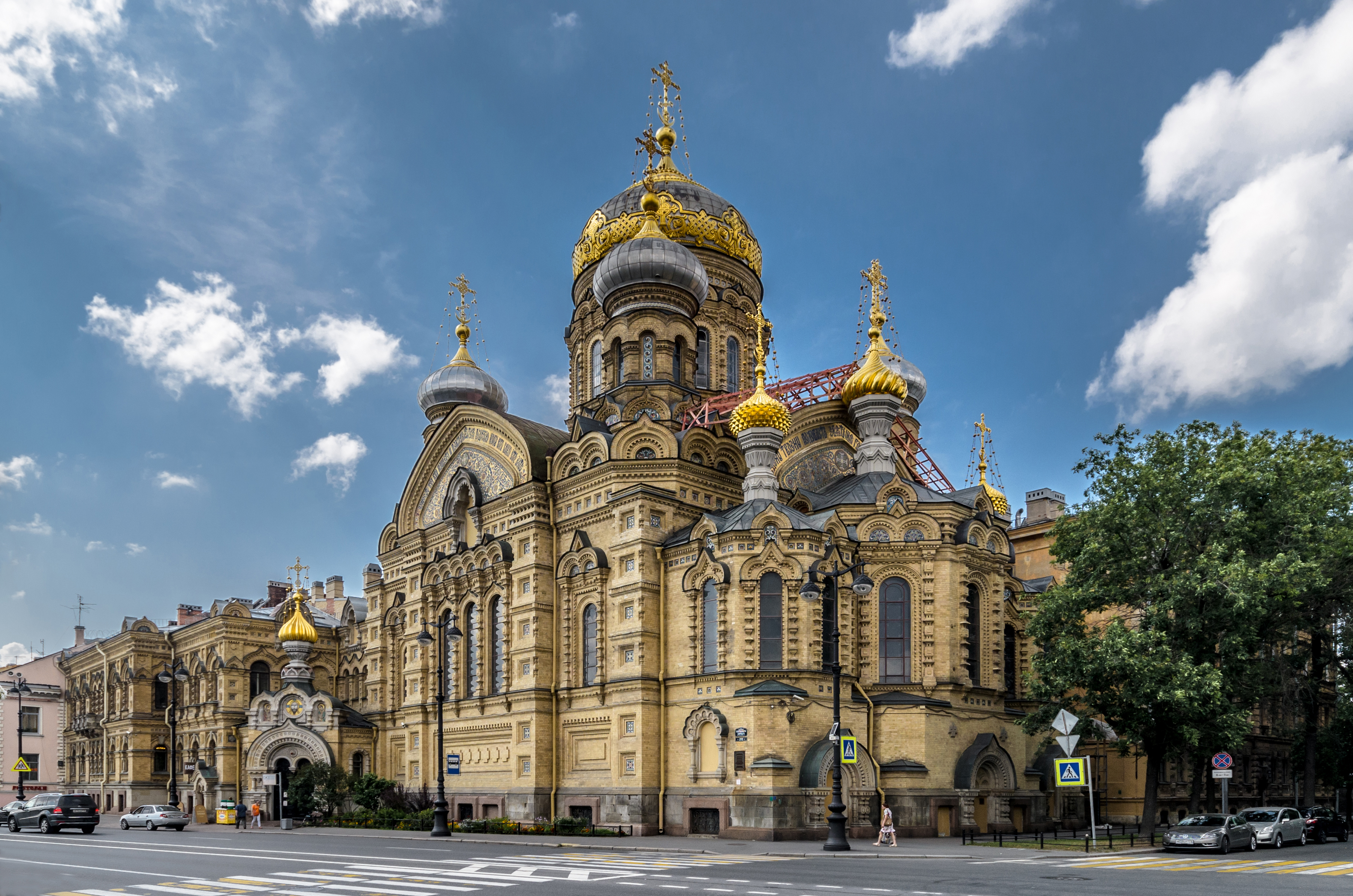Church Of The Dormition Of The Mother Of God (Saint Petersburg) on:
[Wikipedia]
[Google]
[Amazon]
 The Church of the Dormition of the Mother of God (russian: Церковь Успения Пресвятой Богородицы ) is a
The Church of the Dormition of the Mother of God (russian: Церковь Успения Пресвятой Богородицы ) is a
 Construction started 1895. Concrete was used instead of bricks to speed up construction of its main arches. In September 1896, a temporary church was erected inside the temple under construction, where services were constantly held. On September 14, 1897, crosses were placed on the domes. The main chapel was made in honor of the Assumption of the Blessed Virgin Mary, and was consecrated on December 18 1897. In the summer of 1898, the domes were gilded. In 1903, the church was completed.Kosyakov V. A. The construction of the temple and the reconstruction of other buildings of the courtyard of the Kiev-Pechersk Lavra in St. Petersburg. - St. Petersburg. 1900. - 82 p.
Construction started 1895. Concrete was used instead of bricks to speed up construction of its main arches. In September 1896, a temporary church was erected inside the temple under construction, where services were constantly held. On September 14, 1897, crosses were placed on the domes. The main chapel was made in honor of the Assumption of the Blessed Virgin Mary, and was consecrated on December 18 1897. In the summer of 1898, the domes were gilded. In 1903, the church was completed.Kosyakov V. A. The construction of the temple and the reconstruction of other buildings of the courtyard of the Kiev-Pechersk Lavra in St. Petersburg. - St. Petersburg. 1900. - 82 p.
 The Church of the Dormition of the Mother of God (russian: Церковь Успения Пресвятой Богородицы ) is a
The Church of the Dormition of the Mother of God (russian: Церковь Успения Пресвятой Богородицы ) is a Russian Orthodox Church
, native_name_lang = ru
, image = Moscow July 2011-7a.jpg
, imagewidth =
, alt =
, caption = Cathedral of Christ the Saviour in Moscow, Russia
, abbreviation = ROC
, type ...
building in Saint Petersburg
Saint Petersburg ( rus, links=no, Санкт-Петербург, a=Ru-Sankt Peterburg Leningrad Petrograd Piter.ogg, r=Sankt-Peterburg, p=ˈsankt pʲɪtʲɪrˈburk), formerly known as Petrograd (1914–1924) and later Leningrad (1924–1991), i ...
. Its construction started in 1894 when monks from the Kyiv Pechersk Lavra
Kyiv-Pechersk Lavra or Kyivo-Pechers’ka Lavra ( uk, Києво-Печерська лавра, translit=Kyievo-Pecherska lavra, russian: Киево-Печерская лавра), also known as the Kyiv Monastery of the Caves, is a historic Ea ...
decided to expand the monastic branch of the monastery. Work on the construction lasted six years, and the church was designed in the neo-Byzantine
Neo-Byzantine architecture (also referred to as Byzantine Revival) was a revival movement, most frequently seen in religious, institutional and public buildings. It incorporates elements of the Byzantine style associated with Eastern and Orth ...
style by Vasily Kosyakov
Vasily Antonovich Kosyakov (russian: Василий Антонович Косяков; 1862– 5 September 1921) was a Russian Imperial architect and a specialist of the Neo-Russian and Neo-Byzantine architecture in the Russian Empire. He was the ...
.
Construction
 Construction started 1895. Concrete was used instead of bricks to speed up construction of its main arches. In September 1896, a temporary church was erected inside the temple under construction, where services were constantly held. On September 14, 1897, crosses were placed on the domes. The main chapel was made in honor of the Assumption of the Blessed Virgin Mary, and was consecrated on December 18 1897. In the summer of 1898, the domes were gilded. In 1903, the church was completed.Kosyakov V. A. The construction of the temple and the reconstruction of other buildings of the courtyard of the Kiev-Pechersk Lavra in St. Petersburg. - St. Petersburg. 1900. - 82 p.
Construction started 1895. Concrete was used instead of bricks to speed up construction of its main arches. In September 1896, a temporary church was erected inside the temple under construction, where services were constantly held. On September 14, 1897, crosses were placed on the domes. The main chapel was made in honor of the Assumption of the Blessed Virgin Mary, and was consecrated on December 18 1897. In the summer of 1898, the domes were gilded. In 1903, the church was completed.Kosyakov V. A. The construction of the temple and the reconstruction of other buildings of the courtyard of the Kiev-Pechersk Lavra in St. Petersburg. - St. Petersburg. 1900. - 82 p.
1900-1935
In 1922, a chalice, a cross and an altar gospel were stolen from the altar of the church. Temple employees were accused of improper storage of this property. At the end of 1933 - beginning of 1934, another arrest took place where four priests who served in the church came under investigation. Six months later, on August 25, by the decision of the Leningrad Regional Executive Committee, the temple was closed, although services continued until January 23, 1935.Soviet period
After the closure of the temple, the Leningrad military port became responsible for the church. In 1936, it was used as a sports hall. In 1956, a project developed by the Lengiproinzhproekt Institute involved using temple for the construction of the first indoor ice rink in Leningrad. This led to several paintings being destroyed. The ice rink was decorated with portraits of Lenin. The opening of the rink took place in 1961.References
{{coord, 59.93336, 30.27548, format=dms, type:landmark_region:RU, display=title Russian Orthodox churches in Saint Petersburg Russian Revival architecture 1897 establishments in the Russian Empire Churches completed in 1897 Cultural heritage monuments of federal significance in Saint Petersburg